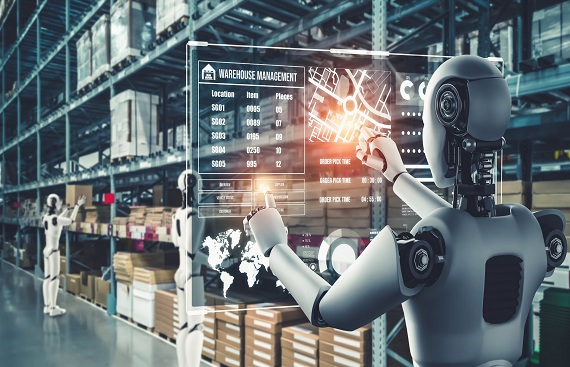The Impact of Automation and Robotics in Revolutionizing Warehouses

The need for efficiency, precision, and speed in warehouse operations has never been greater in today's quickly changing business and corporate environment. The importance of automation and robotics in warehouses has increased as companies expand and customer demands rise. These technological developments transform conventional warehouse methods, streamline operations, and boost overall effectiveness. This shift aims to make warehouses more efficient, adaptive, secure, and intelligent than ever, not just by replacing manual labour with machines. We will examine the many effects of automation and robotics on contemporary warehouses in this discourse and how these technologies are bringing about a new era of simplified logistics and reinvented supply chains.
Types of Automation and Robotics in Warehouses
Warehouse automation includes a variety of robotic and automation technologies that improve supply chain operations. These include robotic pickers, sorters, and automated storage and retrieval systems (AS/RS), which may accommodate various warehouse situations. Drones and automated guided vehicles (AGVs) are changing how materials are moved, tracked, and managed while minimizing human error. In modern warehouses, this collection of technology boosts productivity, quickens order fulfillment, and improves inventory accuracy.
Some notable types of automation and robotics include:
- Palletizing and Depalletizing Robots
- Automated Conveyor Systems
- Warehouse Management Systems (WMS)
- Collaborative Robots (Cobots)
- Parcel Sorting Systems
- Automated Packing Stations
Benefits and Uses of Automation and Robotics in Warehouses
![]()
There are many advantages to integrating automation and robotics in warehouses. Automated systems can do order fulfillment and inventory management more quickly because they can operate continuously. This results in faster order processing, shorter lead times, and more customer satisfaction. Another significant benefit is accuracy. Robots are designed to follow detailed instructions, which reduce errors when sorting, choosing, and packing items.
These technologies also improve workplace safety by taking over risky jobs and lowering the possibility of mishaps involving people. This prevents injuries and promotes less downtime for injured workers while protecting their well-being. Additionally, automation and robotics help to optimize space because they may use vertical storage and small layouts. With the development of technology, these systems have grown more versatile and adaptable, enabling warehouses to manage a range of order volumes and product varieties efficiently.
Key Technologies Empowering Warehouse Automation
Several essential technologies that boost production and efficiency have revolutionized warehouse automation. AI, which directs the complex dance of warehouse processes, is at the vanguard of this transition. AI minimizes downtime by planning optimal routes for autonomous guided vehicles (AGVs), allocating tasks among tasks efficiently, and anticipating maintenance requirements. Robots that use machine learning algorithms are more adaptable, able to learn from new scenarios, and improve their decision-making skills with each encounter. These engineering wonders are strengthened by sensors and vision systems that give robots a real-time understanding of their surroundings and allow them to navigate even the most crowded warehouse locations with astonishing accuracy. The Internet of Things (IoT) smoothly connects these parts, resulting in a symphony of communication and data exchange across various machines, resulting in a flawlessly integrated and precisely calibrated warehouse operation.
Case Studies of Successful Warehouse Automation
![]()
Numerous case studies demonstrate how warehouse automation was successfully implemented, completely altering the logistics environment in the nation. One example is the world's largest online retailer Flipkart, which uses automated guided vehicles (AGVs) and advanced robotics to streamline warehouse operations. Flipkart has raised order accuracy, decreased order fulfillment times, and increased overall efficiency by utilizing automation, which has allowed them to manage large-scale operations effectively. Another interesting example is the pharmaceutical industry, where organizations like Dr. Reddy's Laboratories have embraced automation to uphold strict quality standards and enhance supply chain traceability. They have included technology like RFID tagging and automated storage and retrieval systems (AS/RS) to cut errors and expedite order processing. These success tales demonstrate how warehouse automation has increased operating efficiency and played a crucial role in the industry.
Workforce Collaboration with Robots
Contrary to popular belief, automation, and robotics frequently support human labour rather than replacing it. Cobots, or collaborative robots, support human workers in physically taxing activities and complex manufacturing procedures. Because employees may concentrate on more complicated and creative tasks that call for critical thinking, this teamwork increases productivity and job satisfaction. Workers can upskill and learn to operate and manage cobots as they take on repetitive and tedious tasks, promoting a positive man-machine relationship. The combined power of humans and machines can advance industries into uncharted territory.
Future Trends and Innovations
![]()
Future trends and breakthroughs are brightly on the horizon, which is encouraging. Artificial intelligence, machine learning, and robotics are some of the technologies that will transform numerous sectors. In medicine, personalized care aided by genetic knowledge is becoming more popular. With a greater emphasis on cutting-edge solar and wind power, the energy sector is transitioning towards sustainable alternatives. The development of ‘smart cities’ is utilizing the Internet of Things (IoT) to improve urban living through effective resource management. Complex problem-solving could be entirely changed by quantum computing. As we move forward, the confluence of these discoveries will map an unparalleled path of advancement throughout industries, profoundly impacting our lives.
Finally, automation and robotics are radically changing the world of warehousing and ushering in a period of unparalleled output, accuracy, and efficiency. These innovations' importances in improving warehouse operations will only become more crucial as industries continue advancing. Human-robot collaboration can change the fundamental nature of labour in warehouse environments and reinvent supply chain management. While the journey towards a fully automated warehouse may still be ongoing, its goal ensures a future characterized by simplified procedures, increased safety, and increased effectiveness.
